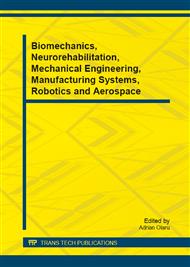p.241
p.247
p.255
p.261
p.267
p.277
p.283
p.289
p.297
Contributions to the Constructive Optimization of an Orientation Module in the Structure of the TRR Industrial Robot
Abstract:
The author of the present paper proposes a constructive version, selected on the grounds of dynamic and organological equations, which enables an optimum design and operation of the (MO Sil) orientation module that possesses two degrees of freedom, to which the prehension device is attached, in the mechanical structure of the TRR-type serial modular industrial robot. This paper aims at highlighting the dynamic modelling of the mechanical structure of the TRR-type robot by using Lagrangian formalism, with aspects regarding the MO Sil module’s organological construction as well as with the 3D modelling of the orientation module in the mechanical structure of the robotic arm. Another important issue that this paper deals with is the mathematical-organological algorithm used for the selection of the servomotors actuating the orientation movable system in the mechanical structure of the robot.
Info:
Periodical:
Pages:
267-273
Citation:
Online since:
December 2012
Authors:
Price:
Сopyright:
© 2013 Trans Tech Publications Ltd. All Rights Reserved
Share:
Citation:


